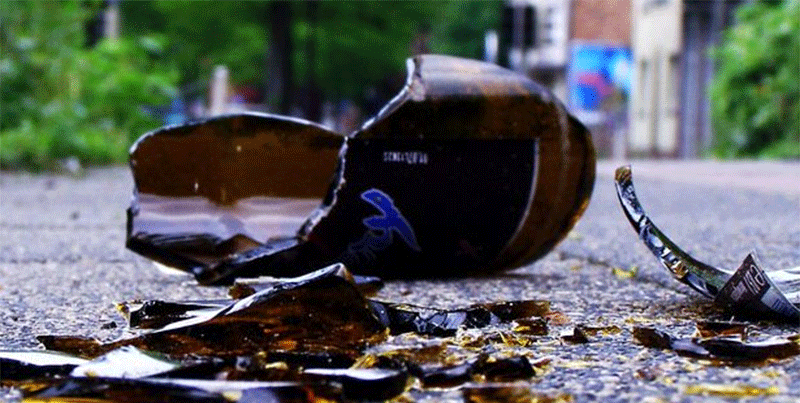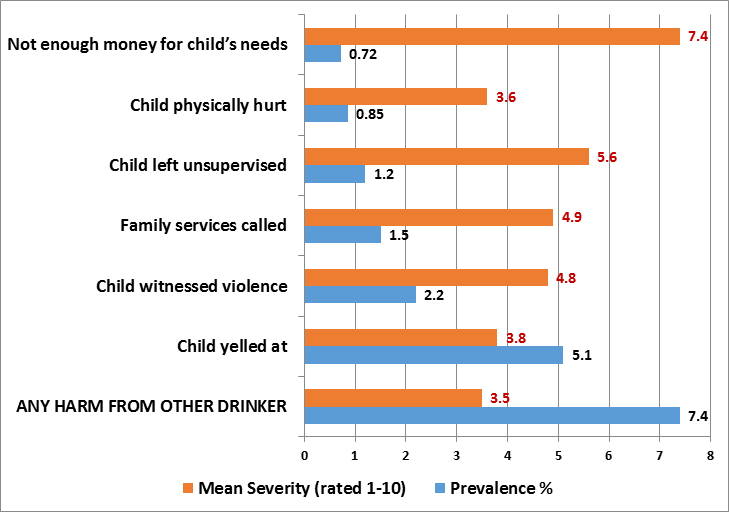Led by Co-PIs Katherine Karriker-Jaffe and Thomas K. Greenfield, the project on Alcohol’s Harms to Others Among US Adults: Individual and Contextual Effects wrapped up recently after resulting in multiple published works, with several new publications on the horizon. The project, which looked at how someone’s drinking affects their spouse or partner or other family member including children, used data from four cycles of ARG’s National Alcohol Survey (NAS), including the latest completed in 2015. The study also sponsored a targeted survey, the US National Alcohol’s Harm to Others Survey, also conducted in 2015, which delved deeper into the extent and kinds of negative experiences stemming from a wide range of harms involving such “second-hand” drinking.
Augmenting the measures of harms from other drinkers – including difficulties with family, finances, assault, and vandalism – historically included in the NAS series, the project also examined effects on others of heavy drinking by friends, coworkers and strangers. The team’s work provided new information on 15-year trends of harms from other drinkers and association of such harms with personal characteristics, as well as insights on how neighborhood disadvantage, alcohol policies and gender related to these harms.
Additional project team members included ARG Center Director and Senior Scientist William C. Kerr, Scientist Madhabika Nayak, Scientist Won Kim Cook, Biostatistician Libo Li, Associate Scientist Christina Tam, Research Associate Deidre Patterson, ARG postdoctoral fellow Pamela Trangenstein, former ARG postdoctoral fellow currently at the University of California, San Francisco, Lauren Kaplan, and Robin Room, Principle Research Fellow and Professor at La Trobe University, Australia.
Harms to Family Members
In assessing family-related harms using all four NAS datasets (2005-2015), analyses showed only financial troubles attributed to other drinkers showed a positive time trend, likely due to the Great Recession. A separate study led by former fellow Lauren Kaplan examined harm to children, documenting that 7.4% of caregivers reported their children experienced one or more of six harms in the past year. Harms included being yelled at (5.1%), witnessing violence (2.2%), being left unsupervised (1.2%), physically hurt (<1%), not enough money for child’s needs (<1%), and having to call family services (1.5%). Results suggest routine screening for family alcohol issues in pediatric settings is warranted.
When assessing early-life victimization, severe childhood physical or sexual victimization was strongly associated with a greater likelihood of experiencing past-year harms from other drinkers for both men and women. Men’s own drinking partially mediated associations between early life victimization and recent aggression by other drinkers.
Impacts on Mental Health
Another set of published studies focused on impacts of alcohol’s harms to others on mental health and quality of life (QoL). Using 2010 NAS data, the team analyzed associations of past-year harms with depression and distress. Family/marital harms, financial troubles, assaults, and vandalism attributed to others’ drinking were each associated with significantly higher depression scores.
New analyses that considered the perpetrators of AHTO using data from the 2015 NAS found 4.9% of respondents reported past-year harm from a family perpetrator, 3.5% by a spouse/partner, 6.1% by a friend or co-worker, and 8.1% by a stranger. People reporting harms perpetrated by known others (but not by strangers) had significantly increased distress, with financial problems due to a family member’s or spouse/partner’s drinking each being associated with greater distress as were feeling threatened or afraid of intimates or of friends who had been drinking.
Using double-robust propensity score weighted models another analysis of the 2015 National Alcohol Survey data showed financial harm due to someone else’s drinking was associated with reduced quality of life and increased distress. Associations with distress also were seen for assaults by partners/family members, but not for assaults by a friend or stranger. Reductions in metal health and quality of life are more profound when victims are harmed by drinking intimates than when friends or strangers inflict the harms. Theseanalyses shed light on possible intervention points to reduce negative impacts of alcohol on families.
Social Context
A key innovation of this project was an in-depth look at contextual effects on AHTO. Considering social environments in which people spend time, study results showed drinking at bars, parties and at home increased risk of assault by another drinker for men while drinking at bars increased risk of family/marital problems for women.
Contribution to Other Studies
External researchers have also used the project data to conduct additional meta-analytic studies and cross-national comparisons. The meta-analyses address the social location of AHTO, harm from known others’ drinking examined by gender and relationship with the harmful drinker, and adverse effects and reduced quality of life for women from a partner’s drinking. Other cross-national comparisons used US and Japanese data on alcohol-related intimate partner violence and early onset of drinking and problem drinking.
Publications to Date
Greenfield TK, Karriker-Jaffe KJ, Kaplan LM, Kerr WC, Wilsnack SC (2015) Trends in Alcohol’s Harms to Others (AHTO) and co-occurrence of family-related AHTO: the four US National Alcohol Surveys 2000 to 2015. Subst Abuse 9 (Suppl. 2):23-31. Get the abstract or full text.
Greenfield TK, Karriker-Jaffe KJ, Kerr WC, Ye Y, Kaplan LM (2016) Those harmed by others’ drinking in the US population are more depressed and distressed. Drug Alcohol Rev 35:22-29. Get the abstract or full text.
Kaplan LM, Nayak MB, Greenfield TK, Karriker-Jaffe KJ (2017) Alcohol’s harm to children: findings from the 2015 United States National Alcohol’s Harm to Others Survey. J Pediatr 184:186-192. Get the abstract or full text.
Kaplan LM, Karriker-Jaffe KJ, Greenfield TK (2017) Drinking context and alcohol’s harm from others among men and women in the 2010 U.S. National Alcohol Survey. J Subst Use 22 (4):412-418. Get the abstract or full text.
Kaplan LM, Greenfield TK, Karriker-Jaffe KJ (2018) Examination of associations between early life victimisation and alcohol’s harm from others. Drug Alcohol Rev 37 (3):365-374. Get the abstract or full text.
Karriker-Jaffe KJ, Greenfield TK, Kaplan LM (2017) Distress and alcohol-related harms from intimates, friends and strangers. J Subst Use 22 (4):434-441. Get the abstract or full text.
Karriker-Jaffe KJ, Li L, Greenfield TK (2018) Estimating mental health impacts of alcohol’s harms from other drinkers: using propensity scoring methods with national cross-sectional data from the United States. Addiction 113 (10):1826-1839. Get the abstract or full text.
Karriker-Jaffe KJ (2016) Commentary: Contextualizing alcohol’s harm to others in space and over time. Nord Stud Alcohol Dr 33 (5-6):483-486. Get the abstract or full text.
Karriker-Jaffe KJ, Room R, Giesbrecht N, Greenfield TK (2018) Alcohol’s harm to others: Opportunities and challenges in a public health framework. J Stu Alcohol Drugs 79 (2):239-243. Get the abstract or full text.
Room R, Callinan S, Greenfield TK, Rekve D, Waleewong O, Stanesby O, Thamarangsi T, Benegal V, Casswell S, Florenzano R, Hanh HTM, Hettige S, Karriker-Jaffe KJ, Obot I, Rao G, Siengsounthone L, Laslett A-M (2019) The social location of harm from others’ drinking in ten societies. Addiction. Get the abstract or full text.
Stanesby O, Callinan S, Graham K, Wilson IM, Greenfield TK, Wilsnack S, Hettige S, Hanh H, Ibanga A, Siengsounthone L, Waleewong O, Laslett A-M (2018) Harm from known others’ drinking by relationship proximity to the harmful drinker and gender: A meta-analysis across 10 countries. Alcohol Clin Exp Res 42 (9):1693-1703. Get the abstract or full text.
Tedor MF, Quinn LM, Wilsnack SC, Wilsnack RW, Greenfield TK (2018) Gender and country differences in alcohol-aggression expectancy and alcohol-related intimate partner violence. Deviant Behav 39 (5):554-575. Get the abstract or full text.
Tedor MF, Quinn LM, Wilsnack SC, Wilsnack RW, Greenfield TK (2018) The gender difference in the association between early onset of drinking and problem drinking between the U.S. and Japan. Deviant Behav 39 (12):1578-1599. Get the abstract or full text.


